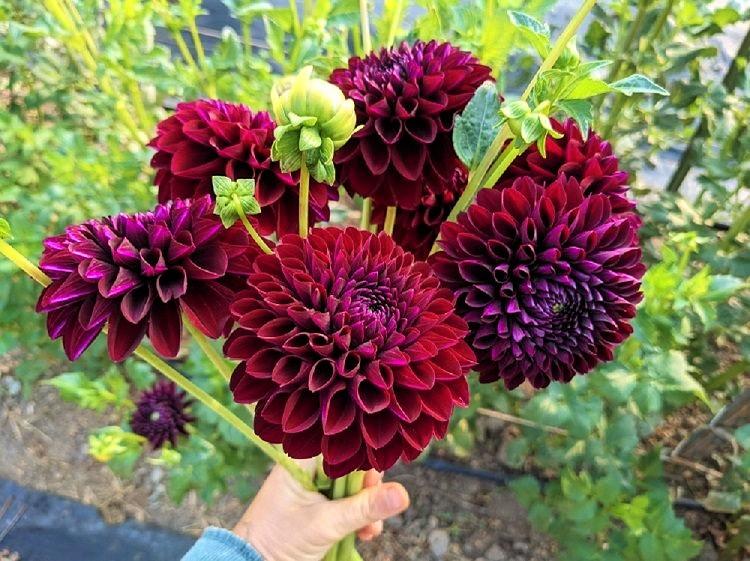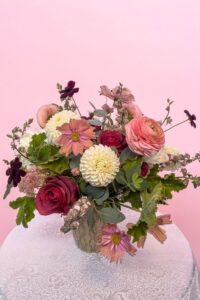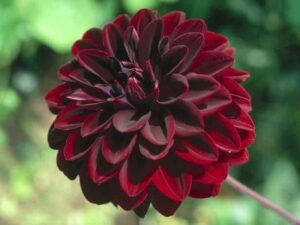Welcome, curious reader, to the fascinating world of dahlia flowers. In this article, we will delve into the rich history and cultural significance behind these beautiful blooms. Discover the secrets and mysteries hidden within their delicate petals and find out why you should pay attention to these enchanting flowers.
What Is Dahlia?
Dahlia, named after Swedish botanist Anders Dahl, is a type of flowering plant that belongs to the Asteraceae family. Native to Mexico, it is known for its showy and vibrant flowers that come in a wide range of colors, shapes, and sizes. Popular in gardens and floral arrangements, dahlias are not only aesthetically pleasing but also hold cultural significance in Mexico as the national flower. They are also associated with various meanings, including elegance, dignity, and everlasting bonds.
Where Did Dahlia Originate From?
The Dahlia flower originated from the mountains of Mexico and Central America. It was first discovered by Spanish explorers in the 16th century and later introduced to Europe. The flower was named after Swedish botanist Anders Dahl. Over time, the Dahlia became popular in Europe and was extensively cultivated. Today, it is grown worldwide and is known for its diverse colors and intricate petal patterns.
The Dahlia holds cultural significance in Mexico, where it is the national flower and symbolizes inner strength and resilience. The history of the Dahlia showcases the global exchange of plants and the enduring beauty they bring.
What Are The Different Types Of Dahlia?
There are various types of dahlias, each with unique characteristics and appearances. Here are some common types:
- Decorative dahlias: Known for their large, fully double flowers with broad petals.
- Cactus dahlias: Have pointed and rolled petals, giving them a spiky appearance.
- Anemone dahlias: Feature a cluster of tube-like petals surrounding a central disc.
- Pompon dahlias: Small and round flowers with tightly packed petals.
- Waterlily dahlias: Resemble waterlily flowers with layers of delicate, curved petals.
Pro tip: When planting different types of dahlias in your garden, consider their size, color, and blooming time to create a visually appealing and diverse display.
What Is The Cultural Significance Of Dahlia?
The cultural significance of dahlia is multifaceted and varies across different cultures. In Mexican culture, the dahlia holds a special place as the national flower, symbolizing the resilience and strength of the Mexican people. In Victorian England, it was seen as a symbol of elegance, dignity, and grace. Even in modern times, dahlia is often associated with beauty and love, making it a popular choice for floral arrangements and garden displays. With its vibrant colors and intricate petals, dahlia adds a touch of beauty and symbolism to any garden or floral arrangement.
What Are The Symbolic Meanings Of Dahlia In Different Cultures?
The symbolic meanings of Dahlia vary across different cultures. In Victorian times, Dahlia was seen as a representation of elegance and dignity. In Mexico, it is considered the national flower and is often associated with celebrations such as Dia de los Muertos. In Native American cultures, the Dahlia symbolizes inner strength and creativity. In some Asian cultures, it is believed to bring good luck and prosperity.
These diverse interpretations of Dahlia’s symbolism highlight its cultural significance and its ability to evoke various emotions and meanings.
Pro-tip: When giving flowers as a gift, it is important to consider the cultural symbolism and meanings attached to them to ensure your gesture is well-received.
How Is Dahlia Used In Different Cultural Celebrations And Festivals?
Dahlia is a versatile flower that is incorporated into various cultural celebrations and festivals, adding beauty and symbolism to the festivities. Here are some ways in which Dahlia is used:
- 1. Floral Decorations: Dahlia is commonly used in floral arrangements and decorations, adding vibrant colors and a touch of elegance.
- 2. Festive Displays: Dahlia blooms are often showcased in flower shows and exhibitions, highlighting their beauty and diversity.
- 3. Festive Attire: Dahlia flowers can also be worn as accessories, such as in floral crowns or corsages, enhancing the festive attire.
- 4. Rituals and Ceremonies: Dahlia flowers may also play a role in religious or ceremonial rituals, symbolizing purity, abundance, or good luck.
In a small village in Mexico, Dahlia flowers hold a special significance in the annual Day of the Dead celebration. Locals decorate the graves of their loved ones with vibrant Dahlia blooms, believing that the flowers guide the spirits of the departed back home. The sight of the colorful Dahlias amidst flickering candles creates a breathtaking and poignant scene.
What Is The History Of Dahlia?
The history of dahlia dates back to the 16th century when Spanish explorers discovered the flower in Mexico. It was later brought to Europe where it gained popularity among botanists and garden enthusiasts. Named after Swedish botanist Anders Dahl, the dahlia became a symbol of elegance and dignity during the Victorian era.
To learn more about the history of dahlia, visit botanical gardens and read books dedicated to the subject. You can also experience the beauty of this flower firsthand by growing your own dahlia garden.
Who Discovered Dahlia?
The credit for discovering the Dahlia goes to a Swedish botanist named Anders Dahl. In the 18th century, Dahl explored the mountains of Mexico and stumbled upon this vibrant flower. As a result, the flower was named after him to honor his significant contribution to the field of botany. Dahl’s discovery of the Dahlia marked the beginning of its cultivation and popularity across the world. Today, Dahlia varieties are cherished by gardeners and flower enthusiasts for their intricate blooms and wide range of colors. Thus, it can be concluded that Anders Dahl is the one who discovered the captivating Dahlia flower.
How Did Dahlia Get Its Name?
The origin of the name “dahlia” is quite interesting, with several theories surrounding its etymology. Here are some possible explanations for how the dahlia got its name:
- The flower was named after Swedish botanist Anders Dahl, who was a student of the renowned botanist Carl Linnaeus.
- When Dahl passed away, Linnaeus honored him by naming the flower after him, calling it “Dahlia”.
- Another theory suggests that the flower was named after the Swedish word “dahl,” which means “valley”. This is because the dahlia was first discovered growing in the valleys of Mexico.
- Some also believe that the name was derived from the surname of a Spanish botanist, Antonio Dahl.
These are just some of the possible explanations for how the dahlia got its name.
What Role Did Dahlia Play In Ancient Civilizations?
Dahlia played a significant role in ancient civilizations, particularly in the Aztec empire. The Aztecs held a deep reverence for the dahlia flower, considering it a symbol of strength and resilience. They incorporated dahlias into religious ceremonies, rituals, and offerings to their gods. Additionally, the Aztecs recognized the medicinal properties of dahlias and used them to treat various ailments. Even today, dahlias continue to hold cultural and historical significance, with different varieties and colors representing various meanings and emotions. Gardeners and flower enthusiasts alike appreciate dahlias for their beauty and versatility in landscaping.
What Are The Uses Of Dahlia Today?
The Dahlia flower is not only admired for its beauty but also valued for its diverse uses today. Some common uses of Dahlia include:
- Garden decoration: Dahlia’s vibrant colors and various shapes make it a popular choice for gardens, adding beauty and attracting pollinators.
- Cut flowers: With their long vase life, Dahlia flowers are widely used in floral arrangements and bouquets.
- Medicinal purposes: Certain Dahlia species have medicinal properties and are used in traditional herbal medicine for treating ailments like inflammation and pain.
- Symbolic meanings: Dahlia flowers are often used to convey messages of beauty, grace, and commitment in floral symbolism.
Fun fact: Did you know that Dahlia tubers can be eaten? In some cultures, the tubers are used as a food source, either cooked or raw, adding a unique flavor to dishes.
Is Dahlia Used For Medicinal Purposes?
Yes, the dahlia plant has been utilized for medicinal purposes as well. Its flowers and tubers have been traditionally used to treat various ailments, as they are believed to possess anti-inflammatory properties. Conditions such as arthritis and muscle pain have been treated with them. In some cultures, the tubers are also used to create remedies for digestive and respiratory issues. However, it should be noted that further scientific research is necessary to substantiate these claims. As always, it is recommended to consult with a healthcare professional before utilizing any plant for medicinal purposes.
Pro-tip: While dahlia may offer potential medicinal benefits, it is crucial to remember that proper medical advice should always be sought for any health concerns.
How Is Dahlia Used In Gardening And Landscaping?
Dahlias are versatile and popular flowers that are commonly used in gardening and landscaping to enhance the beauty and color of outdoor spaces. Here are some of the ways in which dahlias are utilized in gardening and landscaping:
- Bedding plants: Dahlias are often planted as bedding plants, adding vibrant colors and texture to flower beds.
- Container gardening: Due to their ability to thrive in containers, dahlias are a great choice for patio gardens and balconies.
- Cut flowers: The long-lasting blooms of dahlias make them highly sought after for use in floral arrangements.
- Landscaping focal points: With their tall stems and large flowers, dahlias can be used as striking focal points in landscaping designs.
- Border plants: Dahlias can also be used to create borders and hedges, adding a touch of elegance and defining garden spaces.
- Companion plants: By pairing dahlias with other plants, beautiful color combinations can be created and contrast can be added to the garden.
What Are Some Popular Dahlia Varieties?
When it comes to popular Dahlia varieties, there are numerous options to choose from. Some well-known varieties include:
- Cafe au Lait, a beautiful pale pink flower with hints of peach and cream.
- Bishop of Llandaff, which features vibrant red blooms with dark foliage.
- Arabian Night, a deep burgundy flower.
- Karma Choc, a dark, velvety red variety.
Other popular choices include:
- Dahlia ‘Kelvin Floodlight’, with bright yellow and red blooms.
- Dahlia ‘Purple Gem’, with stunning purple and white petals.
With such a wide range of colors and forms available, there is a Dahlia variety to suit every taste and preference.
Frequently Asked Questions
What is the meaning behind the name “Dahlia”?
The name “Dahlia” is derived from the Swedish botanist Anders Dahl, who first discovered the flower in the late 18th century. It is also believed to be named after the Swedish word “dahlie” which means “valley”.
What is the history of dahlias?
The dahlia has a rich history dating back to the Aztecs in ancient Mexico. They were used for medicinal and culinary purposes and were considered a symbol of strength and courage. They were later introduced to Europe in the 16th century and gained popularity as a garden flower in the 19th century.
What are the different types of dahlias?
There are over 50,000 varieties of dahlias, ranging in size, shape, and color. Some popular types include ball, pompon, cactus, and dinner plate dahlias. Each variety has its own unique characteristics and charm.
What is the cultural significance of dahlias?
In Victorian times, dahlias represented elegance and dignity, and were often used in floral arrangements and as a symbol of love and commitment. In modern times, they are still highly valued and are often given as gifts on special occasions such as birthdays, anniversaries, and weddings.
Are dahlias difficult to grow and maintain?
Dahlias are relatively easy to grow and maintain, making them a popular choice among gardeners. They require well-drained soil, ample sunlight, and regular watering. With proper care, they can bloom continuously from summer to fall.
Can dahlias be used for anything other than decoration?
Yes, dahlias have many practical uses as well. The flowers and tubers of certain varieties are edible and can be used in salads, stews, and other dishes. The tubers are also used in traditional medicine and have been found to have anti-inflammatory and antioxidant properties.



